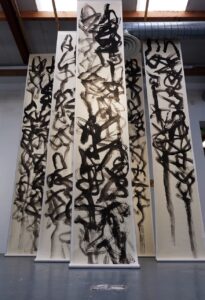PhD Research Exhibition 2024
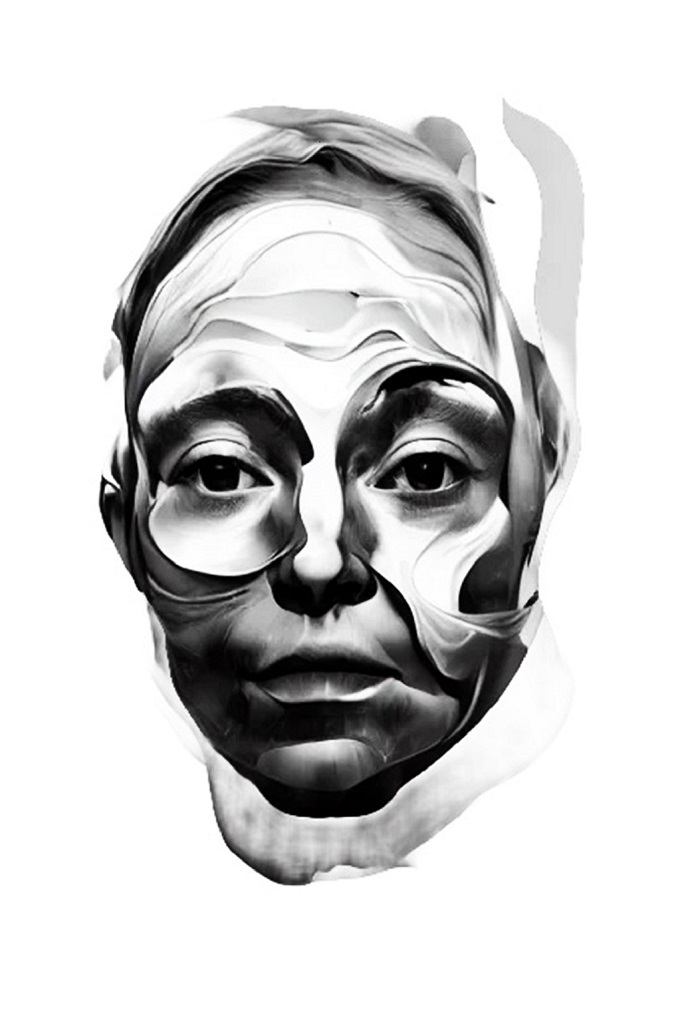
February 1-23, 2024
FADWA BOUZIANE
HELLE HELSNER
JD WHITMAN
JOSEPH HENDEL
KAT COPE
KATERINA GRIBKOFF
LEA FARRELL
LING LIU
Opening Reception: Thursday, February 1, 6-8pm
Gallery Hours: Mon-Fri 9:30am-5:00pm
contact@burrencollege.ie | +353 65 7077200
Peer Reviews of PhD and MPhil 2024 Exhibition
Please click on the link below to download reviews of the PhD/MPhil student work in the exhibition, written by BCA MFA students.
Fadwa Bouziane
I’m introducing myself, my name is Fadwa Bouziane, born in a small town called Cowansville in Québec. My mother Farida Bouziane is an Amazigh Indigenous Moroccan and my father Ulrick St-Louis is Haitian. I begin by acknowledging where I am from, because where I’m from is what leads me to where I am right now, at this specific moment in time. I am a presenting Black woman, Bi, raised in a Muslim household where the bible and the Quran were sitting at the same night table. I’ve grown up between three distinctive cultures trying to find a sense of belonging and being forced into white spaces.
I taught at Emily Carr University and Capilano University in Vancouver and now
pursuing my education in Ireland as a Ph.D. candidate second year. My practice explores racial trauma as it intersects with other forms of oppression, specifically gender-based oppression. Complex racial traumatic events must be expelled from the mind and body to restore mental and physical equilibrium. If trauma is not addressed, the repercussions can be chronic pain, mental illness, and degenerative disease. According to Gabor Maté “When the body says no: the cost of hidden stress”, symptoms can manifest not only by repetitive behaviours, panic attacks and accelerated heartbeat and auto-immune disorder. During my research, I will focus on how complex racial trauma affects the Black body in White spaces.
Furthermore, the environment impacts the mind and the body of black individuals to such an extent that it cannot be separated from the equation. “Constantly living with the perceived or real threats associated with the colour of our skin leads to greater internalized stress, which in turn leads to physical and psychological illnesses that disproportionately affect us” Mary-France Winte’s book ‘Black Fatigue: How Racism Erode the Mind, Body and Spirit” explains the dramatic impact on Black bodies of unresolved anti-Blackness. The colonial patriarchy that continues to support the status quo is the predominant source of this power imbalance.
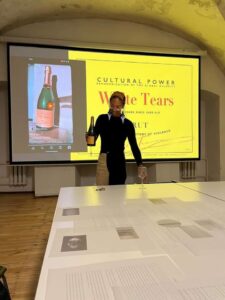
Helle Helsner
Danish born Helle Helsner is an artist and educator based in West Cork. She works primarily through sculpture and drawing with a foundation in materiality and ancient technology. Helle has exhibited extensively nationally and internationally – with collections in the Danish state collection, The OPW and the RTE collection. She is a full time lecturer in MTU Crawford College of Art and Design.
Examining landscape, memory and material though the lens of bronze casting technology my starting point has been the landscape of the Beara Peninsular. The extended copper mining industry from prehistoric copper mines to the 19th century industrialised mining and associated industries – constitutes a microcosm which has formed the base of my investigations into the impact mining and materials extraction have in the landscape both in a physical sense and in a semiotic sense. By spending time in this environment working within my practice I hope to come to an understanding of and with the landscape, the memories it carries and the materials it offers, not just in Ireland but worldwide.
Asking the questions: How does ancestorial technology, knowledge, and materiality inform and challenge material value systems? Does slag have any value? Can colliery spoil tips be anything but environmental blemishes on the landscape? What other waste materials pertaining to the mining industry can afford value to a contemporary art practice.
This question has formed the starting point of my research and have thrown up unexpected responses, material considerations and social issues within my practice.
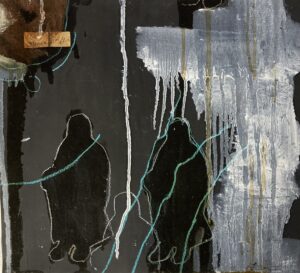
JD Whitman
JD Whitman is an installation artist, educator, and ocean advocate from the United States. She received an MFA in Photography, an MFA in Sculpture with honors, and an MA in Studio Arts from the University of Iowa (2015-2019); a Post-Baccalaureate in Fine Art from the Burren College of Art (2014); and a BA from the University of Chicago with honors (2013). Currently, JD is a 2nd year PhD student working as an External Expert in SciArt for the European Commission’s Joint Research Centre in Ispra, Italy.
Rooted in policy-driven marine science and ocean conservation, JD’s research practice aims to creatively illuminate anthropogenic threats to the ocean, potential solutions, and action steps for individuals and communities. Through transdisciplinary research, she investigates how art, scientific inquiry, technology, and public engagement can be combined to circumvent negative ecological emotions in environmental education, facilitate effective science communication, drive community-centric action, and influence policy.
Through collaborations with environmental industry specialists and cultural and creative practitioners worldwide, she develops and implements community-specific SciArt experiences to test new methods for translating complex scientific research to target audiences through nature-based experiential learning and immersive visual storytelling.
These experiences work to bring the ocean to viewers, develop awareness for vulnerable communities disproportionately affected by climate change, empower or provide agency to youth leaders, help establish circular community networks fostering sustainable eco-action, and spark positive conversations surrounding environmental concerns and solutions.
As a PhD candidate, JD focuses on addressing the global crisis of plastic particulates (microplastics and nanoplastics). She is exploring ways transdisciplinary research and socially engaged practice can disseminate policy-driven research on plastic particulates to channel eco-anxiety into informed eco-action.
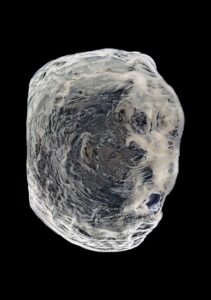
Website: https://www.jdwhitman.com
Instagram: @jdwhitman
Joseph Hendel
Joseph Gold Hendel is a performance artist, theatermaker, electronic music composer, and intermediate python coder from New York living in rural Western Ireland. He is a fourth year Ph.D. student at the Burren College of Art (University of Galway) where he researches how performance and AI-assisted art can represent, critique, and analyze contemporary masculinity and male power under digital capitalism. Recent work includes: Mandroid Streams, a work-in-progress theatre piece performed at the Galway Theatre Festival 2023; the AI-based digital video piece Solstice at 126 Gallery in Galway for the Acts of Healing and Modality show, curated by Dr. Áine Phillips; a participatory instagram-based performance Tomorrow 404 at the Laneway Gallery in Cork City; and xxXtedXxx, an “anti-Ted Talk” performance experiment at the Not Quite King, Not Quite Fish artistic research symposium in Vilnius, Lithuania.
My artistic research explores how performance and A.I.-assisted digital art can represent, critique, and critically analyze contemporary normative western masculinities + male power as they are expressed and understood under networked, neoliberal technocapitalism. I create digital video and live performances pieces that attempt, from the inside, to forge a critique of essentialist and idealist notions of sex, gender, and technological power, using neural net A.I. technology and my own signifying, power-laden body to question ideological premises around what constitutes gendered expression, social/digital subjectivity, and individual human agency.
I see generative A.I. neural nets (like ChatGPT and image-generating A.I.s like Midjourney) as Contested Social Input/Output Machines. They are political in nature – who trains and controls them have implications for the distribution of social power, and, therefore, they can become sites of potential resistance. On the input side, they are vast, searchable databases of human expression and allow us to discover and leverage the contemporary social antagonisms embedded inside their training data. On the output side, they are a contemporary collage-maker’s most powerful digital tool, allowing for the automated visual and textual remixing of signifiers into new (often ambivalent) signifying forms.
I scrape the margins of these machines and let them produce forms for me to engage with and compose around. I play at centering and decentering myself in them. And I use the machine’s power to encourage the formation of new identifications and modes of entangling with the world that can question the ways masculinities are described and performed.
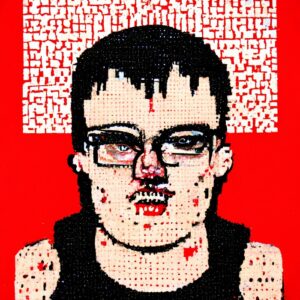
Kat Cope
Kat Cope’s research asks, How can sculptural costume and performance generate metaphorical armour to process and transform unresolved complex trauma? Their practice focuses on creating wearable sculptural costumes, and performance. Kat holds a B.A. from Mount Holyoke College (2005) and an MFA from the University of Massachusetts Dartmouth (2009). They have exhibited their work in numerous group and solo exhibitions internationally. In August 2023, Cope performed at Gallery126 in Galway for the event Acts of Healing and Modality. They are now in their fourth and final year of PhD research at Burren College of Art. Cope seeks to help adults with complex trauma by sharing their own lived experience.
Action Equals Courage is a short film of a performance I have been developing over the past year. The performance incorporates elements of Buddhist philosophy, mindfulness, Qigong exercises, and guided meditation as transformative action to process unresolved complex trauma.
I have explored sculptural collars as a protective costume in my research in response to my ADHD and Autism diagnosis. In the film I wear one of these Blinder Collars. The wearer of the collar becomes unaware of their periphery, like a horse wearing blinkers this limitation can reduce overstimulation and gives the wearer a reprieve from perceived danger. Viewers are welcome to try on the collar and leave their feedback.
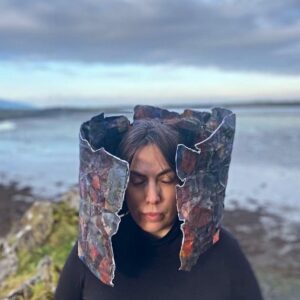
Katerina Gribkoff
Katerina Gribkoff is a visual artist, curator, and researcher based in County Galway. She has a BFA in Drawing from the Pratt Institute (NYC) and is a current PhD candidate at the Burren College of Art, where she also maintains a dye/pigment garden.
Her co-curated show Meant to Fade was exhibited at Laneway Gallery in Cork (June 2023) and she (along with co-curator Phoebe Tohl) will be bringing the show abroad for Ireland in Germany 2024. She recently exhibited at K-Fest (2023) and IMMA’s Eco Festival (2022). In 2024 she will be exhibiting work at the Irish Embassy of Indonesia, KAVA, and 126 Gallery in Galway.
My practice centres care-full processes and improvisation as ways of corresponding and connecting with the more-than-human world. I work closely with dye plants within a cultivated garden space as part of a larger art-making system, and make sculptural and quilted works to tell the stories of this work: to bring the garden into the gallery. Quilting mirrors many of the repetitive acts of care performed in the garden during growing season. Watering, picking, touching, and pulling outside, turns to sewing, smoothing, pinning, and cutting inside the studio.
I am interested in how material can both facilitate and dictate relations between humans and plants, and continually visit farms and gardens around Ireland, as models of these mediated relationships. I document material use at these sites using film photography, often capturing the imperfect blend of natural and found materials: what is local, abundant (including repurposed waste), fulfils a need, and supports growth. And through skill-sharing and creative workshops, I aim to aid others in connecting to and collaborating with plants through colour extraction and material play.
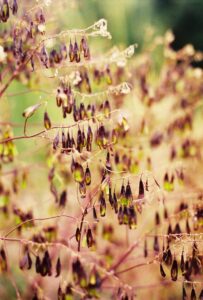
Lea Farrell
Lea Farrell is a visual artist born in Transylvania living in Ireland. She has a Diploma in Fine Art Painting Techniques and a BA(Hons) in Animation. Her artistic background is mixed between commercial and fine art. Her art experiments with drawing, painting and digital media. She considers drawing to be the main skeletal component of her work that she uses as an investigative tool and as an honest response to any question.
Lea’s research critically examines the agency of the nuclear family during the development of immersive digital age. The work dissects the basic elements of this traditional social construct and re-builds it with a layered analysis filtering it through the lenses of techno philosophical and sociological discourses. It takes apart the components of existing social identity and questions its place and belonging in decentralised digital society. This research draws its evidence from existing theoretical socio-cultural and artistic backgrounds while aiming to find new understandings, ways, and interpretations through mixing traditional methods with emerging technology.
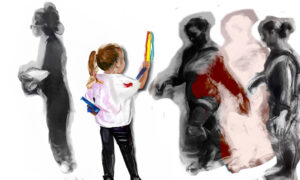
Ling Liu
Ling Liu is a sound and lens-based artist. Born and educated in Hangzhou, China, she completed a BFA and MFA in Chinese painting and Chinese art history, a MFA in electronic media, now she is a PhD candidate in practice based artistic research. Even while painting for almost her entire life, she now explores sonic and imagery media as essential for combining her passion to unravel the development of Chinese art and history as both a deep and intricate tradition and one that continuously reverberates in the contemporary world of expanded media. Her works traverse media of any and all kinds; each bringing its own possibility, each its own necessity, each its own encounter with history. Her recent work investigates the relationship between the reclaim of tradition and the form of contemporary.
Hearing Rhythm, Seeing Rhythm III
Hearing Rhythm, Seeing Rhythm is a series of sonic-visual integration explores how the rhythmic rules of traditional Chinese poetry are heard and seen. It investigates the relationship between traditional poetry, calligraphy and painting, the intricate relationship between acoustic and visual, and the relationship between Chinese lyric aesthetics and contemporary multimedia artistic expression. From the visualization of rhythmic rules to the integrated sonic-visual spaces; from the experimentation of contemporary art within the framework of Chinese aesthetics to the application of traditional aesthetic yijing and atmosphere into multimedia sonic-visual spaces, this series of works, as a systematic attempt to reclaim the traditional rules of rhythm as well as to retrieve pre-modern history and traditional culture, has come to its third stage.
Hearing Rhythm, Seeing Rhythm III is the extension and continuation of 听·见·韵 叁 (exhibited in Jiangsu Art Museum, Nanjing, Sep. 2023). In this work, I continue to perform sound works based on the rhythmic rules of traditional poetry. At the same time, adopt abstract calligraphic drawing techniques that combine the cursive writing (traditional calligraphic style) with the expressive means of freehand Chinese painting to become a kind of visual expression of the rhythmic cadence in the sound component. In the sonic-visual space formed by the traditional brush, ink, silk and rice paper, and the painting scrolls, the sonic rhythm is integrated into the ink and brush, while the visual is incorporated into the sound.
Website: https://www.hearingrhythmseeingrhythm.com/
Personal website: https://lingloriliu.com/
